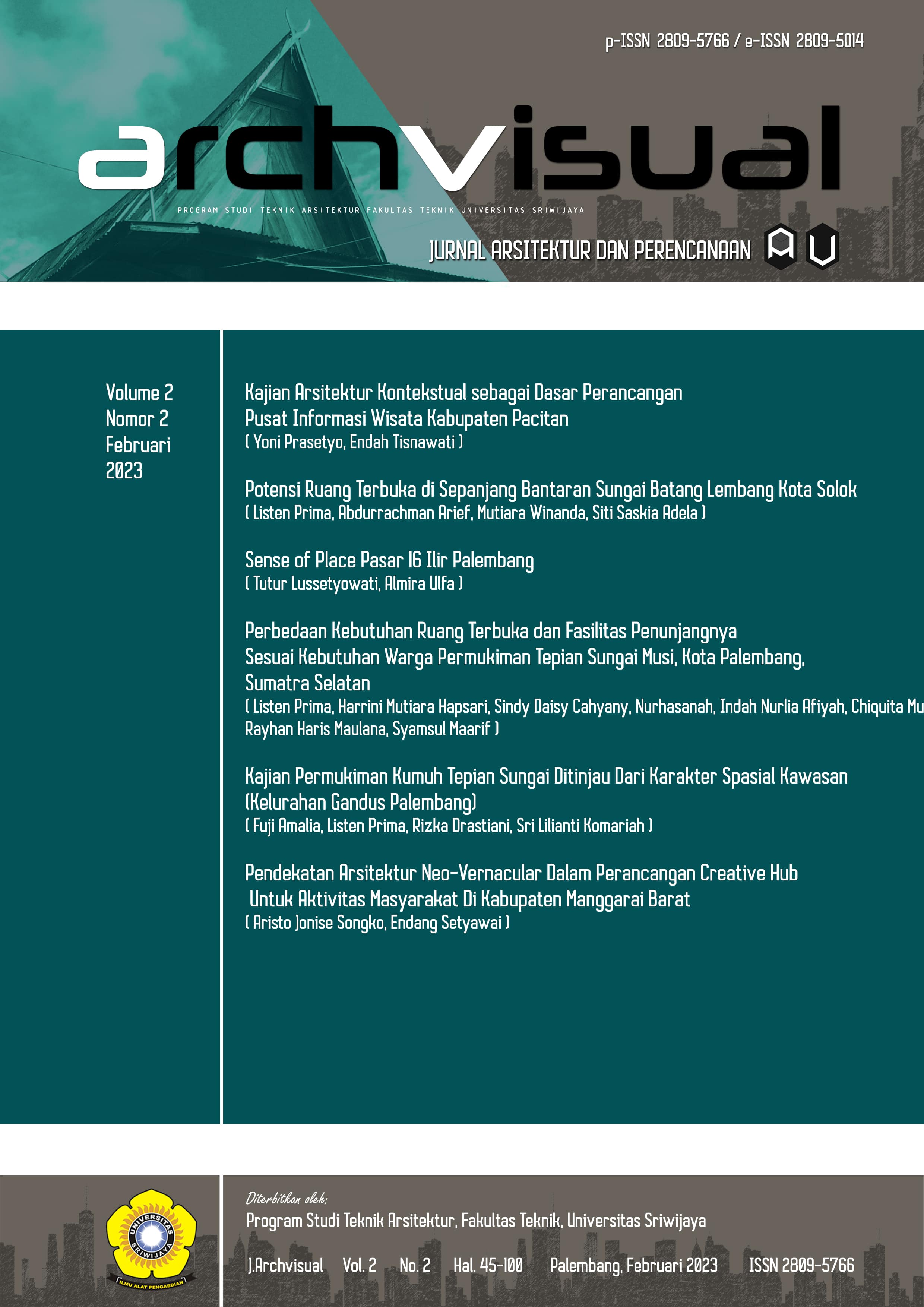Sense of Place Pasar 16 Ilir Palembang
Main Article Content
Abstract
A sense of place is an important element that can strengthen the relationship between the user and the place. The character of a place greatly influences how a person evaluates and interprets it. The 16 Ilir Market, one of Palembang's oldest markets, has played an important role in the city. But now, the market is starting to face many problems, such as congestion problems and the physical shape of the building. In addition, the interior of the building becomes less attractive. These factors influence the sense of place at 16 Ilir Market. The purpose of this research is to look at the current sense of place at Pasar 16 Ilir, which is influenced by several aspects. The analysis will refer to several aspects that can give rise to a sense of place for users, such as: activity; meaning; and physical setting. The method used is a qualitative research method, which consists of collecting field data and interviewing managers, merchants, and visitors. Then the data was processed using the descriptive analysis method. According to the study's findings, the sense of place in 16 Ilir Market is shaped not only by the market itself, but also by the surrounding area. Interestingly, the area around the market has a bigger role in creating the sense of place.
Article Details
Section

This work is licensed under a Creative Commons Attribution-NonCommercial 4.0 International License.
How to Cite
References
Agumsari, D., Ekomadyo, A. S., Gumilang, M., Bintana, D., & Susanto, V (2020) Capturing Genius Loci of Riparian Culture: The Case of Musi River Palembang, Atlantis Press.
Ahmed, M., & Zeile, P (2020) Places’ Representation on Social Media, Real Corp.
Aliyah, I., Setioko, B., & Pradoto, W (2017) Spatial Flexibility in Cultural Mapping of Traditional Market area in Surakarta (A Case Study of Pasar Gede in Surakarta), City, Culture and Society, vol. 10, 41–51. https://doi.org/10.1016/j.ccs.2017.05.004
Awaritefe, O. D (2004) Motivation and Other Considerations in Tourist Destination Choice: A Case Study of Nigeria, Tourism Geographies, vol. 6, no. 3, 303–330. https://doi.org/10.1080/1461668042000249638
Bleszynski, T. P., & Widyastuti, D. T (2018) Sense of Place pada Kawasan Taman Tepian Mahakam, Samarinda, September (Jurnal Arsitektur Dan Perencanaan), vol. 1, no. 2, 1–12.
Carmona, M., Heath, T., Oc, T., & Tiesdell, S (2003) The Dimensions of Urban Design. http://www.elsevier.com
Crompton, J. L (1979) Motivations for Pleasure Vacation, Annals of Tourism Reseearch.
Dameria, C., Akbar, R., & Natalivan, P (2017) Siapa Pemilik Sense of Place? Tinjauan Dimensi Manusia dalam Konservasi Kawasan Pusaka Kota Lama, Prosiding Seminar Heritage IPLBI 2017, https://doi.org/10.32315/sem.1.b235
Do, D. T., Cheng, Y., Shojai, A., & Chen, Y (2019) Public Park behaviour in Da Nang: An Investigation into How Open Space is Used, Frontiers of Architectural Research, vol. 8, no. 4, 454–470. https://doi.org/10.1016/j.foar.2019.05.006
Foote, K. E., & Azaryahu, M (2009) Sense of Place, 96–100, http://www.elsevier.com
Irwanto, D., & Santun, M (2010) Venesia dari Timur: Memaknai Produksi dan Reproduksi Simbolik Kota Palembang dari Kolonial sampai Pascakolonial.
Lengen, C., & Kistemann, T (2012) Sense of Place and Place Identity, Review of neuroscientific evidence, Health and Place, vol. 18, no. 5, 1162–1171, https://doi.org/10.1016/j.healthplace.2012.01.012
Montgomery, J (1998) Making a City: Urbanity, Vitality and Urban Design, Journal of Urban Design, vol. 3, no. 1, 93–116. https://doi.org/10.1080/13574809808724418
Rhomadona, R. P., Hairi, M. I. A., & Amaliatulwalidain (2016) Evaluasi Pelayanan Kawasan Pasar 16 Ilir Pasca Kebijakan Penertiban dan Tata Kota Palembang Tahun 2004. Jurnal Pemerintahan Dan Politik, 1.
Whyte, H (2001) The Social Life of the Small Urban Space, Project for Public Spaces.

